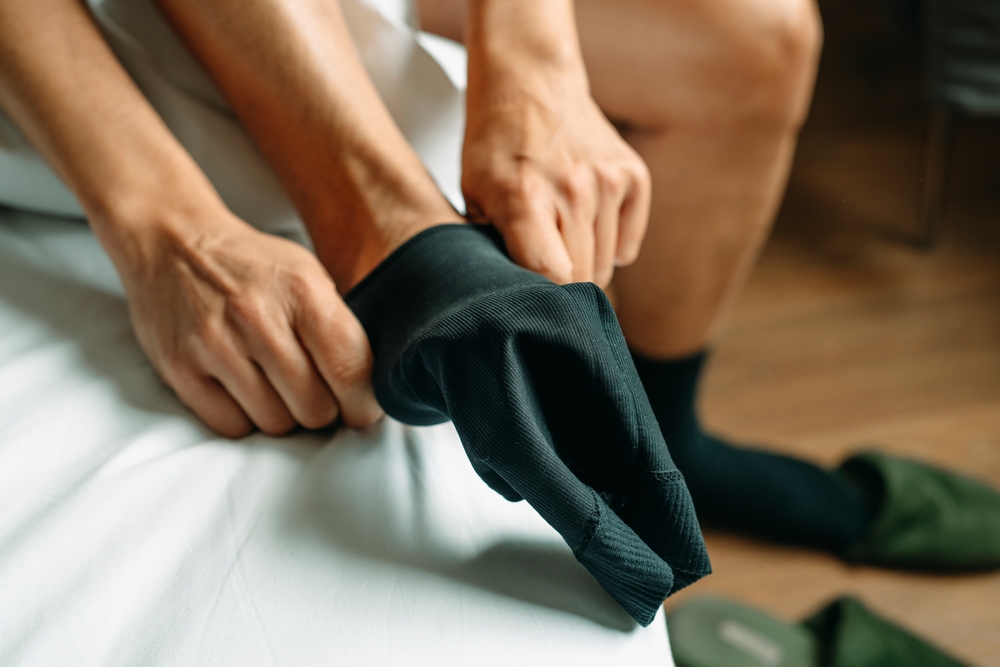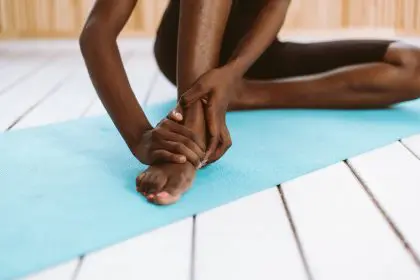That pair of socks sitting in your drawer might be the sleep solution you’ve been searching for. While some people can’t stand the thought of covering their feet at night, wearing socks to bed does something fascinating to your body’s temperature regulation system that could transform your sleep quality. This seemingly minor bedtime choice triggers a cascade of physiological changes that influence everything from how quickly you fall asleep to how deeply you cycle through sleep stages. Understanding this peculiar relationship between your feet, temperature regulation, and sleep quality might just convince even the most committed bare-foot sleeper to reconsider their nighttime routine.
The surprising science of warm feet and cool sleep
Your body’s temperature regulation works in mysterious ways, especially when it comes to sleep. Counter to what you might expect, warming your feet with socks can actually help lower your core body temperature, which is crucial for quality sleep.
Here’s how this paradox works. Your hands and feet contain specialized blood vessels called arteriovenous anastomoses. These unique vessels can open wide, allowing significant amounts of blood to flow through your extremities, effectively radiating heat away from your core.
When you warm your feet with socks, these blood vessels dilate, increasing blood flow to your feet. This process, called vasodilation, actually helps dissipate heat from your core by redirecting warm blood to your extremities, where heat can escape more easily.
This redistribution of heat plays a crucial role in your sleep cycle. Your core body temperature naturally needs to drop by about 1-2 degrees Fahrenheit to initiate and maintain sleep. By warming your feet, you’re essentially helping your body release internal heat more efficiently, accelerating this core temperature drop.
Think of it like opening windows on opposite sides of a house. Just as this creates airflow that cools the entire house more effectively than opening a single window, warming your extremities creates a temperature gradient that helps cool your core more efficiently than if your entire body were the same temperature.
The temperature-sleep connection decoded
The relationship between body temperature and sleep quality goes far beyond simple comfort. Your circadian rhythm, the internal clock that governs your sleep-wake cycle, is intimately tied to your core temperature fluctuations.
Your body temperature naturally follows a 24-hour cycle, reaching its peak in the late afternoon and its lowest point about two hours before you typically wake up. This temperature dip is not just a byproduct of sleep but an active driver of it.
As evening approaches, your core temperature begins to fall, signaling to your brain that it’s time to produce melatonin, the hormone that promotes sleepiness. The faster this temperature drop occurs, the more quickly sleep onset typically happens.
During deep sleep stages, your body temperature reaches its lowest points. If your core remains too warm, you’ll spend less time in these restorative sleep phases and more time in lighter sleep, leading to that frustrating “I slept, but don’t feel rested” experience.
By wearing socks to bed, you’re essentially hacking this system. The warmth at your extremities accelerates the core cooling process, potentially helping you fall asleep faster and achieve deeper sleep states throughout the night.
Who benefits most from sleeping in socks
While sock-wearing at bedtime can benefit many people, certain groups might notice particularly dramatic improvements in their sleep quality.
People with chronically cold feet often struggle with sleep onset. Their constricted blood vessels in the extremities make it harder for the body to efficiently redistribute heat away from the core. For these individuals, warming the feet with socks can break this cycle, improving blood flow and accelerating the core temperature drop needed for sleep.
Women, who statistically report cold feet more often than men due to hormonal influences on circulation, might find sock-wearing particularly beneficial. Female bodies tend to conserve core heat more efficiently, sometimes at the expense of extremity warmth, making external warming of the feet especially effective.
Those with Raynaud’s syndrome, a condition characterized by extremely reduced blood flow to fingers and toes, often find that sleeping in socks not only improves comfort but also enhances overall sleep quality by addressing the circulation issues that might otherwise interfere with temperature regulation.
Older adults, whose temperature regulation systems naturally become less efficient with age, can particularly benefit. The natural circadian temperature swing diminishes with aging, which partially explains the increased sleep problems in this population. Socks can help amplify the compromised temperature signals.
Interestingly, people with insomnia often show abnormal temperature regulation patterns, with their bodies resisting the normal evening decline in core temperature. For these individuals, the vasodilation promoted by wearing socks might help override this disruption and reinforce proper temperature signals for sleep.
Beyond basic cotton
Not all socks are created equal when it comes to sleep benefits. The material, fit, and even color can influence their effectiveness for temperature regulation during sleep.
Materials that balance warmth with breathability work best. Merino wool stands out as particularly effective, as it provides warmth while wicking away moisture and allowing for temperature regulation. Bamboo and cashmere also offer excellent breathability while providing gentle warmth.
The ideal sleep socks should be loose-fitting, especially around the ankle. Tight elastic bands can actually restrict blood flow, counteracting the vasodilation benefit that makes socks helpful for sleep in the first place. Look for socks specifically designed for sleep, with non-restrictive tops.
For those who dislike the sensation of full socks, bed socks that cover just the foot while leaving toes exposed offer a compromise. These provide warmth to key blood vessels while avoiding the fully enclosed feeling that some find uncomfortable.
Temperature-regulating fabrics with phase-change materials can provide sophisticated benefits. These specialized materials absorb excess heat when you’re too warm and release it back when you cool down, helping maintain an optimal foot temperature throughout the night.
Compression socks, while beneficial for certain medical conditions, generally aren’t recommended for sleep. Their purpose is to restrict blood vessel expansion, which is exactly the opposite of what promotes the temperature regulation benefits of sleeping in socks.
The psychological side of sock sleeping
Beyond the physiological effects, wearing socks to bed can have psychological impacts that influence sleep quality, sometimes in surprisingly powerful ways.
The ritual of putting on specific sleep socks can serve as a valuable sleep cue, signaling to your brain that it’s time to wind down. This becomes part of a sleep hygiene routine that helps condition your mind for rest, similar to other bedtime rituals.
The comfort sensation of warm feet creates a feeling of relaxation that helps quiet an active mind. This comfort can be particularly beneficial for people whose racing thoughts interfere with sleep onset.
For those with sensory sensitivities, finding the right sleep socks can make a dramatic difference. Some people are highly attuned to the feeling of bedsheets against their feet, finding it distracting or uncomfortable. The right pair of sleep socks provides a consistent, comfortable barrier that eliminates this sensory distraction.
Cultural and personal associations matter too. Some people have strong negative associations with wearing anything to bed, including socks. For these individuals, the psychological discomfort might outweigh the physiological benefits, highlighting the importance of personal preference in sleep habits.
Practical tips for sock sleeping success
If you’re interested in trying socks as a sleep aid, these practical approaches can maximize the temperature regulation benefits while avoiding potential drawbacks.
Consider putting socks on about an hour before bedtime to give the vasodilation effect time to begin working before you attempt to fall asleep. This head start helps your core temperature begin dropping earlier in your bedtime routine.
Layer strategically if you tend to experience temperature fluctuations during the night. Starting with socks but keeping your upper body lightly covered gives you the benefit of foot warming while still allowing heat to escape from your core.
Try the warm bath and socks combination for maximum effect. A warm bath or foot soak 1-2 hours before bed initially raises your core temperature, but this triggers a compensatory cooling response. Following this with socks magnifies the cooling effect, potentially creating ideal sleep conditions.
Keep a spare pair by your bed for those nights when you start without socks but wake up with cold feet. Having them within reach means you won’t fully wake yourself up searching for them in the middle of the night.
Reconsider your socks if you wake up with sweaty feet. This indicates you’ve moved from helpful warmth to excessive heat, which can actually disrupt sleep. Try a more breathable material or a lighter-weight sock.
The bottom line
The relationship between wearing socks to bed and improved sleep isn’t just an old wives’ tale. It’s backed by the physiology of temperature regulation and its profound impact on sleep quality. By warming your feet, you’re not just addressing cold discomfort, you’re strategically influencing your body’s internal thermostat to create ideal conditions for deep, restorative sleep.
Whether you’re a lifelong sock-sleeper or someone who’s always kept their feet bare, understanding this connection gives you another tool in your sleep optimization toolkit. Like many aspects of sleep, personal preference plays a significant role, and what works for one person may not work for another.
Next time you’re struggling to fall asleep or stay asleep, consider the humble sock as a potential solution. This simple addition to your bedtime routine might just tap into your body’s natural temperature regulation system in exactly the right way to help you get the quality sleep you’ve been dreaming about.

















